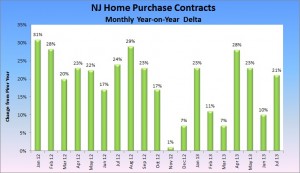Have New Yorkers finally discovered Jersey City?
As property values soar even in Brooklyn neighborhoods once viewed as on the fringe, New Yorkers are looking across that other river that separates Manhattan from the rest of the world: the Hudson. And some of them are heading to Jersey City, which has a flintier personality than Hoboken, its preppy neighbor to the north. New Jersey’s second-largest city, it now has a branch of the popular Williamsburg arcade-bar Barcade; farm-to-table restaurants; and a new mayor who worked for Goldman Sachs, served in Iraq and rappelled down a skyscraper.
Jersey City has long attracted the Wall Street crowd to its splash of waterfront high-rises that promise cheaper rent and a speedy ride to Manhattan. But for years, the rest of the city was an afterthought with a reputation for high crime, failing schools and a lack of night life. But as the economy and housing market improve, other Jersey City neighborhoods are enjoying newfound attention, with boutique storefronts opening and New Yorkers steadily moving in.
…
“Jersey City is good for 30- to 40-somethings who aren’t interested in hanging out in Williamsburg anymore,” said Kevin Pemoulie, the former chef of Momofuku Noodle Bar, who last year along with his wife, Alex, opened the restaurant Thirty Acres in the Van Vorst Park neighborhood. He, like many others who have moved to Jersey City, also liked the in-transition quality of the area.
With New York City rents reaching new highs, housing prices by comparison are still reasonable in Jersey City. The average rent here was $1,900 a month during the second quarter of the year, according to data provided by Trulia. In early July, the average listing price for a home downtown was $604,000 and in Hamilton Park was $426,000, according to data provided by Liberty Realty.
Richard LeFrak, chief executive of the LeFrak Organization, which began developing the Newport neighborhood in 1986 when it was rail yards and warehouses, is one who has noticed a change. “I would say, in the last three years, when you say you live in Jersey City,” he said, “people don’t look at you like there’s something wrong with you.” In the next decade, LeFrak plans to add condos, a hotel and an outdoor swim club to Newport.
…
“Brooklyn is just ridiculous — it’s expensive,” Mr. Pemoulie said. “It’s frustrating to be there. All of my friends ended up moving out.”
Indeed, some parts of Brooklyn have even eclipsed Manhattan in rent prices. The average rent for a one-bedroom in Williamsburg in July was $3,155 a month, a price point rivaling those of many Manhattan neighborhoods, according to a market report by MNS. Even less-developed Brooklyn neighborhoods are commanding a premium: in Bushwick in July, the average rent for a one-bedroom was $1,900.
Still, for many New Yorkers, crossing the Hudson is a psychological hurdle, even if Jersey City now has a Two Boots Pizza and a coffee shop that serves Blue Bottle Coffee.
“The PATH train is like the train to Hogwarts,” said Kip Jacobson, 41, alluding to the “Harry Potter” series. Mr. Jacobson moved to the Van Vorst Park neighborhood from Williamsburg a year ago with his wife, Samantha, and their young son.
…
Developers are building, and not just along the waterfront. Citywide, 2,610 units of housing are under construction and 11,405 more have been given the green light, according to the mayor’s office. In fact, the city has enough developable land available to fill all of Hoboken, which is one square mile. But the construction is still not keeping pace with demand. In July there was only a two-month supply of available homes downtown, according to Liberty Realty.
“If you see a vacant building in Jersey City,” said Joseph V. Covello, the owner of Liberty Realty, “someone is bidding on it or renovating it.”

